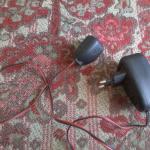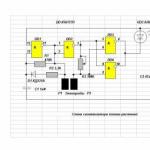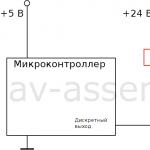How to make a transparent leaf from a tree. Leaf skeletonization (6 options)
Skeleton maple leaves
Skeletonized leaves are leaves that have only veins left. The soft tissues of the leaf (scientifically "epidermis") are removed in various ways, and the so-called "skeleton" remains - an openwork mesh of veins.

Different types of venation
Skeleton leaves can be easily bought in a flower shop, in a florist shop, in a decor store... You can also order it in a shop. It's fast, simple, convenient. Another plus is that the store sells skeletons of trees that do not grow in our area. For example:
Leaves of religious ficus (ficus religiosa) or Bo tree (tree Bo), Bodhi, Banyan; pipal (Peepal or Pippal):
 Ficus religious (Ficus religiosa)
Ficus religious (Ficus religiosa)

Skeletonized Ficus Leaf ((Ficus religiosa)
Leaves of the rubber tree or Hevea brazilian (Hevea brasiliensis):

Rubber tree (Hevea)

rubber tree leaf
Magnolia leaves (Magnolia):


Magnolia (Magnolia virginiana L.)

Magnolia (Magnolia_acuminata)

Magnolia (Magnolia_acuminata) Mango leaves (Mangifera indica):

Mango (Mangifera L.)

Mango (Mangifera L.)
However, buying leaves in the store is not always possible and not for everyone. Yes, and the choice is limited to only two or three types. It is much more interesting to make skeletons yourself!
There are many articles on the Internet on the topic of leaf skeletonization, but alas, all these articles are, in fact, just reprints of the same foreign master class. And not the best. Why not the best?
- Firstly, boiling leaves in washing soda is mentioned everywhere - not the best option, since not everyone can find this powder in their city. I didn't find it either, although I've been looking for a long time.
- Secondly, this soda copes with very few leaves. Some of our crafters use baking soda instead of washing soda, but it works even worse, if not to say that it does not work at all. Yes, some leaves are scaly, but even just boiling in hot water without any additives is enough - soft, loose leaves, such as maple, this is enough. It is generally ridiculous to talk about soaking in green tea - complete nonsense.
- Thirdly, there are much more effective and affordable means.
So how do you actually effectively skeletonize leaves?
There are several ways:
- Dry
- Wet
- Natural
- Chemical
Dry way
The dry method is good when you urgently need one or two skeletonized leaves. You are tormented to do more, since it takes about 15-20 minutes of vigorous action per sheet.
The method seems to be simple - take a brush and beat a leaf with it. But! Having bought a special brush with a comfortable handle and after working for about ten minutes with this brush over a leaf, I was very upset - nothing worked out for me! And all because the bristles on the brush were made of synthetics, and besides, not hard enough.
So remember - the brush should only be made of natural bristles, the pile is not too long. Please note - the stiffer the bristles, the better! You can buy such a brush in the market or in a hardware store, they are usually designed for cleaning clothes or shoes. By the way, you can attach a long handle yourself.
We take very fresh leaves, without spots and holes, lay them out on a newspaper and beat them with a brush. You will break the soft tissues of the leaf, leaving only the veins or the skeleton of the leaf! The method is ideal for maple leaves, sycamore, Benjamin's ficus, poplar, ivy, etc.


Skeletonized sycamore leaf
Press-dried leaves can also be used. In this case, you will get not a skeletonized leaf, but simply an openwork one - also an interesting option. And here just the brush may not be very hard.

Leaf skeletonization

skeletal leaves

skeletal leaves

skeletal leaves
Natural skeletonization method
The leaves are remarkably skeletonized in a natural way - that is, nature itself creates such leaves, you just need to notice and pick them up in time.
How does this happen? And here's how - the leaves get wet in the rain, under the snow, lie on the damp ground, they are trampled on with heels, so they turn into a net by themselves. I usually collect such leaves when the snow melts. Also, the leaves can be "eaten" by some insects:

skeletal leaves

skeletal leaves
In order not to rely on nature and not to wait for a suitable leaf to come across, we arrange a natural skeletonization of the house. Pour plain water into a jar and put the leaves there. Close the lid, leave alone for about a month. As a rule, a month is enough, but sometimes even less time is needed. Then we take out the leaves and watch how the flesh of the leaf departs. If the sheet is softened enough, rinse it under running water with three fingers so that all the mucus comes off.
I experimented with Benjamin Dunetti's ficus leaf, which had been in the water for a month. After that, it exfoliated, and I simply removed the film from it, which covers the sheet on both sides. It turned out to be a very soft and delicate skeletonized leaf (although initially ficus leaves are very hard). The structure resembles that of a dragonfly's wing, doesn't it?






In principle, the lanterns themselves are ossified, naturally on a bush (from rain and snow) - you just have to not miss the moment and collect them in time before they rot. And you can also put them in water and after a couple of weeks get ready-made "skeletons".
And in this way it’s great to skeletonize physalis. These are such bright orange lanterns on a branch, florists love to use them to make bouquets of dried flowers.


In principle, the lanterns themselves are ossified, naturally on a bush (from rain and snow) - you just have to not miss the moment and collect them in time before they rot. And you can also put them in water and after a couple of weeks get ready-made "skeletons".



wet way
If you need a lot of leaves, it is most effective to skeletonize them in a wet way. Pour the leaves with water and add the Mole powder (pipe cleaner). In general, any aggressive household chemicals will do. You can take soda, of course, but I do not guarantee the result.
So, throw two or three tablespoons of the powder into the water and boil the leaves for several hours. For maple leaves, an hour is enough, for sycamore leaves (and other hard leaves) - two to three hours. Moreover, the smaller the plane tree leaf, the more time it needs to be cooked.




Next, we take out the leaves and wash them in a bowl of water. Three fingers to remove the pulp. Rubber gloves with pimples also help. If the pulp does not come off - cook more. Hard leaves need to be brushed with a toothbrush on a wooden board. At the same time, we constantly moisten the toothbrush in water.




What kind of leaves oskeleize well? These are, first of all, maple leaves, plane trees. Poplar leaves (black or silver), birch, linden, aspen, oak, garden blueberry, walnut, alder, ficus leaves are excellent.

Skeletonized black poplar leaves

Skeletonized linden leaf

Skeletonized sycamore leaf

Skeletonized silver poplar leaf
Chestnut leaves are very delicate, but they can also be skeletonized. You just need to straighten them right in the water, and then get them already straightened, prying them with a saucer or a wooden spatula.



After skeletalizing, I leave the leaves to air dry. And then I just iron it with a warm iron. You can immediately put under the press, or immediately iron the wet leaves with an iron - that's how you want. Very flimsy leaves cannot be shifted - they will tear or wrinkle. Let them dry first in a straightened form - the way you got them out of the water, and then transfer them wherever you want.

Chemical method
The chemical method - in fact, is also, in fact, wet. But here you do not boil or boil anything. Just fill the leaves with bleach (“Whiteness” will do) in half with water and wait. As they turn white - pull out, rinse. It turns out a white transparent leaf. You can also beat with a brush. And you can skeletonize the leaves by boiling and then bleach - it will turn out generally like the thinnest white lace - very beautiful.



Well, now the most important question - why did we actually do all this? Why are they needed, these skeletonized leaves?
First of all - such leaves are beautiful in themselves. And very unusual. An openwork cobweb made of veins, a transparent sheet, soft, as if made of fabric ... Of course, such a creation of nature undoubtedly attracted the attention of a person with artistic taste.
Here, for example, the artist Irina Ivi covers skeletonized leaves with gold or silver paint, then collects them into a composition in the form of a branch and seals them between two glasses. It turns out a very unusual transparent picture, in the depths of which weightless leaves mysteriously shimmer...




From lacy, openwork leaves, you can make interior dishes! The artist Kay Sekimachi was so impressed by the beauty of the skeletonized leaves that she decided to use them to create simple, yet very effective bowls and vases. And the fact that all these thousand dollar (!) vases have already been sold out clearly indicates that the audience appreciated the natural beauty of the skeletons:




You can also draw on skeletonized leaves! In ancient India, paper has always been expensive, and with leaves they grew everywhere and completely free. So the masters guessed to use foliage instead of paper. The leaves were processed by long soaking in water (wet method). It turned out an interesting material, thin, but at the same time durable. Then the skeletons were painted and sold.




And here is how the modern Kochetova Nadezhda draws:

Kochetova Nadezhda "Red Beauty"

Kochetova Nadezhda "Joy"

Kochetova Nadezhda "Song"

Kochetova Nadezhda Barn Owl
What is there to draw! Feather applications can be made on the leaves:


You can make miniature straw applications:




You can even print photos!




Do you think that's all? It would seem, well, how else is it possible to create paintings on leaves, and even skeletonized ones? Are there other options? Oddly enough, but there is! It turns out that images can be created on ordinary leaves by partially skeletonizing them! The way it is done in China: plane tree leaves (they are called "plane trees" there) are boiled in a special solution, and then the leaf is removed with a knife to the veins according to the sketch.

Leaf Carving Art

Leaf Carving Art

Leaf Carving Art

Leaf Carving Art

Leaf Carving Art

Leaf Carving Art
You can also embroider on skeletonized leaves! See what a gentle spring picture you get:

You can use them in patchwork or quilt (patchwork) as one of the elements of a complex background:


Gisele Blythe

Deborah Gregory
You can also use skeletons in felting - decorate imitation wool surfaces - felted scarves, dresses, hats, bags ... For example, the way Lyubov Voronina from the city of Ivanovo does it:

Lyubov Voronina

Lyubov Voronina

Lyubov Voronina

Lyubov Voronina
Eco-friendly wallpaper with a unique decor is made from skeletonized leaves. After all, each sheet is unique in itself!




They also make decorative paper:




Skeletons decorate postcards, albums (scrapbooking), passport covers, etc.:

Handmade gifts (Ekaterina)

[email protected](irochka84) "Envelope for money"

Evgenia (kjane) "Eco-postcard"

Marina Fazylova (m-tomcat) Passport Cover
They decorate the interior, wedding bouquets, napkins:

Bridal bouquet

Love (luba-pol) Wedding bouquet "Air mood"

Festive napkin
Skeleton leaves are great for decoupage of vases, cups, boxes, watches, etc.:

TARI (tari-elkiotter) Cup with skeletons

N@stenk@ Vase "Leaves in ice"

Elena Efremova (zzorik.ru) Cup with skeletons

Olga Koshkina (xsanf) Physalis salad bowl

Zuli Watch "Autumn Breath"

Murashka (Smile at your home) Wall clock and napkin holder

Oksana Mineeva (Kseniya) Hedgehog in the Fog Watch

Oksana Mineeva (Kseniya) Decorative plate "Hedgehogs"
For decoupage or felting lamps:

Skeleton vase

Skeleton vase

Wool "Skeleton lampshade"

Skeleton night light

Lampshades with skeletons

Mironova Inna (various colors) Lamp "Autumn Forest"

Lamps with skeletons

Lamps with skeletons
In addition, they create jewelry in various ways.
For example, skeletons are poured with epoxy resin - earrings, rings, necklaces are obtained ...

DarKera Necklace "Magic Tree Leaves"

"Pendant with skeleton"

NATURE IN A DROP (smolka-uvelira) 
NATURE IN A DROP (smolka-uvelira)

Anastasia Arinovich (bisenkan) Ice Leaf Pendant

Creative workshop "Mastyushka" Pendant "Autumn leaf"

NATURE IN A DROP (smolka-uvelira) Rings

Anastasia Arinovich (bisenkan) Earrings
Or they electroplated the skeletonized sheet with gold, silver or copper, creating a metallic patina of iridescent colors. It turns out amazing and unique in its beauty pendants ...





Katya Design Jewelry

Leonova Marina Leaf fall "Pomegranates"

Handmade by AlekSanta

Leonova Marina Falling leaves "Cat's eye and amethyst"
And of course, skeletonized leaves are used by florists!
The appearance of crafts from the same material can be strikingly different from each other. This can be achieved by a variety of methods. For leaf crafts, just take leaves from different trees, varying degrees of yellowness, and so on. But what about changing the structure of the sheet?
Leaf skeletonization is a great way to make a completely new material for crafts.
First of all, it’s probably better to figure out what it is? Leaf skeletalization is the process of removing the soft tissues of a leaf without affecting the veins and stem. In this case, the "skeleton of the sheet" remains connected by a thin transparent film (or without it), hence the name.
In principle, "leaf skeletons" can be bought in stores and used. However, you can "crank" it yourself. There are several ways to do this and each of you will be able to choose the most convenient and suitable for yourself. We will now consider some of them with you.
The simplest method of skeletonizing leaves is dry, using a brush.
Take a regular brush and with vigorous movements begin to slap it on the surface of the sheet. After 15-20 minutes of intensive work, we will get a "skeleton".
The disadvantage of the method is that you cannot make many leaves with it. And the quality is not always at the highest level. Some veins are not preserved. A lot depends on the brush you choose.
Consider another way to skeletonize leaves - using soda.
We will need a saucepan, leaves, water and soda.

Put the leaves in a bowl. We fill them with soda diluted in water. Pour 1 teaspoon of baking soda into 1 liter of water. However, you can vary the proportions yourself.

In this solution, cook the leaves for half an hour (30 minutes).



We take out the leaves, put them on a napkin or soft cloth. Sponge (or with a brush) carefully remove the pulp. The main thing is not to overdo it and not damage the veins!

During cooking, the leaves may be slightly deformed. You can give them their former even shape using a regular press from books.
When skeletonized, the leaves become discolored. You can give them a new color (any!!!) with the help of food coloring. We dilute the dye with water, dip the leaves into it, wait a bit, take it out and dry it. You can dry it simply by blotting with a napkin or sponge.
Leaf skeletonization is a long and painstaking, but very interesting process! Under the action of water, air and chemicals, the pulp is separated from the veins, forming an openwork contour in the form of a leaf.
Processing methods
It should be said that skeletonized blanks can also be bought in needlework stores or via the Internet. There you will find leaves of trees that cannot be found in your city: magnolia, Canadian maple, cork tree, bamboo.
But do not give up the process of obtaining skeletons at home - it is much more interesting to watch how the leaf turns into an openwork plexus of veins in your hands. In addition, this method is more economical than buying ready-made leaves.
Skeletoning is based on several methods, depending on how many sheets you need, what density and rigidity they are.
This technique is used if you need to skeletonize 1-2 leaves. You can dry dry and more blanks, but it will take a long time - 1 sheet is cleaned for 15-20 minutes.
All you need is a pulping brush. Pay attention to the pile: buy brushes only with natural bristles. And the tougher it is, the better you will carry out skeletonization.
Lay the light-colored leaves in front of you and start brushing them. So you separate the pulp from the veins, leaving only the frame.
In the same way, you can process dried herbarium leaves, but you will get not a sinewy, but simply an openwork blank.
natural way
In a similar way, skeletonization of leaves occurs in a natural environment - hence the name of the method.
- Pour water into a jar, put a sheet there, close the lid and leave it in this state for a month. Follow the process carefully - you may need less time.
- When the top layer of the sheet leaves, remove the workpiece and rinse it under running water from the mucus.
- Carefully separate the pulp with your hands or with the help of thin brushes of medium hardness.
Pretty blanks will remain in your hands. Skeletonization is completed by drying in a dry place for 2 days. Thus, it is good to process ficus leaves and physalis fruits.
wet way
Wet skeletonizing is used if you need to cook several leaves at once.
- Put the leaves in a pot of water and add 2-3 tablespoons of a chemical solvent like Mole.
- Boil the leaves for several hours. The average cooking time is 2-3 hours for medium hardness blanks.
- After cooking, remove the leaves from the pot and rinse with water in a bowl.
- With your fingers, rubber gloves, or a toothbrush, start scrubbing the flesh away from the veins.
To learn more about wet skeletonization, watch the following video.
Carefully spread the straightened blanks in a dry, well-ventilated place and leave to dry for 1-2 days.
Skeletonizing leaves with chemistry is similar to the wet method. The difference is that you do not need to cook the blanks.

Just fill the leaves with whiteness with water in a one-to-one ratio. You can take out the blanks when they turn white and begin to lose the pulp.
During drying, all blanks must be placed under the press so that they turn out flat and even.
The success of the separation of the pulp from the skeleton depends mainly on the stiffness and thickness of the leaf. The leaves of such plants are easier to skeletonize than others: poplar, plane tree, linden, oak, blueberry, birch, aspen, ficus. Experiment with cherry and currant leaves.
Think also about decorating the skeletons: their coloring, lamination, additional coating.

Staining of skeletonized leaves can be done in several stages:
- in the process of separating the pulp from the veins - whiteness, potassium permanganate will help you;
- after the final drying of the product - use watercolor or gouache, coloring cans.
Cover the finished product with varnish or fixative to make it more durable. Use sequins, rhinestones and beads for decoration.
Types of needlework
Skeletonization of leaves is only the initial stage. Due to the openwork appearance, the blanks began to be used to create a wide variety of do-it-yourself products.
Below you can find some popular uses for skeletonized leaves.
Leaf paintings
Branches or other patterns are drawn on the finished background, blank sheets are glued - a wonderful picture is obtained.

In addition, skeletonized sheets often act as a canvas for images themselves. And not only images - such a type of needlework as artistic carving on leaves has recently appeared.
Texturing
Leaves are also used to give a special texture to some materials.
In quilting and patchwork techniques, skeletons are sewn into fabric. And masters of felting wool roll blanks to products so that the pattern of veins seems to be visible from the inside.

But the most amazing invention is the pressing of leaves under pressure into paper. So skeletonization contributes to the appearance of beautiful sheets for crafts and photo wallpapers with skeletons inside.
Scrapbooking and decoupage techniques were among the first to take note of leaf skeletonization as an economical way to get new working material.

Decoupage with openwork blanks is used for dishes, lamps, furniture. And the leaves, carelessly glued to postcards and albums, add airiness to the product.
Decorations with particles of skeletonized leaves have recently been rapidly gaining popularity. Almost every craftsman considers it his duty to try the creation of pendants by pouring skeleton leaves with epoxy resin.

The following technique is also common: an openwork sheet is covered with gold or silver plating, fixed with a fixative varnish and used as an independent pendant.
Skeleton leaves: master class
Try skeletonizing for a simple beer glass decorating tutorial. All you need: skeletonized blanks, glue, clear varnish, red and yellow paint on glass, glasses.
- Cover one side of the skeletons with glue and randomly glue them to the glasses.
- In between the leaves, paint the leaves with paints. Dotted leaves will look like real carved blanks.
- Cover the glasses with a fixative varnish and leave to dry.

These autumn-style beer glasses make a great gift for the holidays. Especially in October, when the Beer Festival traditionally takes place. Moreover, they are designed to cheer you up on a dark autumn evening.
To create original ikebana using the scrapbooking technique, needlewomen often use leafy skeletons. Transparent, thin, openwork, like the wings of a dragonfly, the leaves always fascinate with their unearthly beauty. Such material can be purchased at a specialized store. Better yet, do the skeletonization of the leaves at home.
Popular ways
Crafts from skeletonized leaves are striking in their diversity. This material can decorate various postcards, wall panels. Most often, skeletonized leaves are used in the scrapbooking technique.
On a note! Only hard leaves are suitable for creating a skeleton, in particular, maple, walnut, oak.
There are three main ways to turn a green leaf into a skeleton:
- natural;
- wet;
- dry.
In the first case, nature will do all the work for you. In autumn, the trees shed their leaves. First, the leaves lie under heavy rains, then under a layer of snow. As soon as nature pampers with the first spring rays of the sun, you need to collect the leaves. They are already softened. All you have to do is clean and dry them. But this method is not suitable for all needlewomen, since you have to wait more than one month.
The second way is dry. This option for harvesting skeletonized leaves is suitable if you urgently need one or two pieces. We carefully soak the leaf in cold water, dry it, and then scrape off the entire green part with a brush.
On a note! The brush must be made of natural bristles. Choose a brush with the maximum level of hardness.
The third method is wet, it is the most popular. Baking soda and harsh chemicals are used to harvest skeletonized leaves. It is about this method that we will talk in more detail today.
If you decide to do such an interesting type of needlework, first learn the technique of harvesting material. Skeletonization of leaves is not an easy process. But when you master the basics of preparing leaf skeletons, you can comprehend more complex ways, for example, create colored or transparent leaves.
The traditional way of skeletonizing leaves
Skeletonizing leaves with soda is one of the most popular ways to get rid of their green cover and leave only the skeleton and veins. Some needlewomen are skeptical about this method. But as they say, you never know if you don't try.
Advice! Experienced craftswomen advise choosing ficus or tangerine leaves for skeletonization. But Kalanchoe leaves are not suitable for these purposes, because they are too saturated with water.

- 10-12 Art. baking soda;
- 800-1000 ml of water;
- brush;
- cutting board;
- leaves.
Advice! The darker the leaves become, the easier it will be for you to remove the skin from them.
Step by step description of the process:

Skeleton leaves using household chemicals
Check out another way to skeletonize leaves at home. The recipe is very simple. You will need a household cleaner. It can be any substance for clearing blockages in pipes or plumbing.

Required materials and tools:
- cutting board;
- leaves;
- water;
- brush;
- household cleaning agent;
- glass container with a volume of 0.5 liters.
On a note! The tool should completely cover the leaf.
Step by step description of the process:

On a note! Be sure to wear gloves when working with chemicals. If you need to discolor the leaf and make it transparent, use regular bleach or Whiteness.
Attention! It is impossible to set an exact time frame. It all depends on the composition of the selected agent and the degree of its aggressiveness.
I really like decorations based on natural materials, and today I suggest you learn how to make colored skeletonized leaves. But first, see how you can use skeletonized leaves in decor.
Skeleton leaves can be decorated with sequins and beads, they can decorate any flower arrangement or become a New Year's decor. as well as original accessories.


To make such earrings, in addition to skeletonized leaves, you must use.

Skeletonized leaves are used in a variety of surfaces.


With the help of skeletonized leaves, you can create a unique ornament

A rose made of skeletonized leaves will be the highlight of the decor in the house.

Skeleton leaf garland

So, let's start making skeletonized leaves. To do this, you need to collect leaves with identified veins. You can involve children in the cooking process, they will choose colors. Despite the fact that today you can buy artificial skeletonized leaves, many people prefer to make them with their own hands, because it is so cheap and more interesting. You can use any leaves for this.

So, in order to make colored skeletonized leaves, you will need the following materials:
- Leaves
- soda food
- Toothbrush and brush
- Food coloring
- Paper towel

How to make leaf skeleton
First, collect the leaves. Try to collect leaves with coarse veins, such as oak, maple. However, you can try other leaves.
Fill a small saucepan with 2 cups of water and 3 tablespoons of baking soda. Place the foxes in a saucepan and leave to cook for at least two hours, periodically add soda.


When the leaves darken, you can remove them from the heat. Take the leaves out of the pot and set aside. Now you can start skeletonizing.

Remove the leaves and use a toothbrush to gently remove the pulp, then use the brush to finish removing the pulp from the leaves. Do everything carefully so as not to damage the skeleton of the leaves.

If you want to make a transparent sheet, then place it in a solution with bleach and water. Leave until the green color is completely gone. Let dry.

If you want to make multi-colored leaves, then place the leaves in a solution with food coloring.
Now you know how to make colored skeletonized leaves. You can use them for various purposes as a separate decoration or in compositions. Success in creative work!





